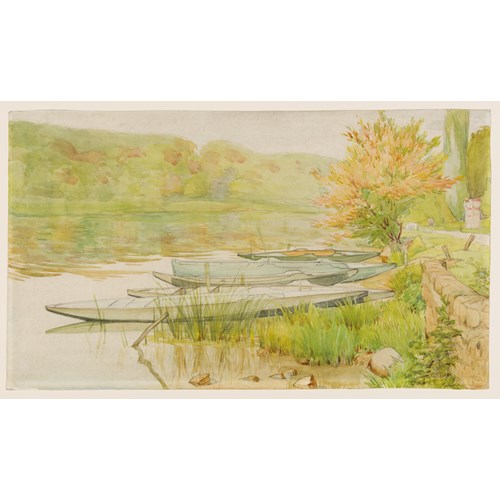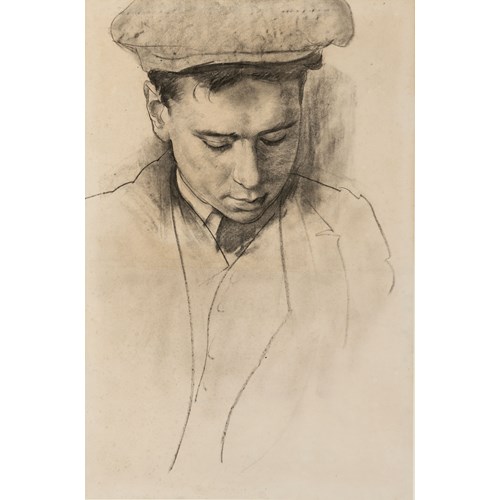The present sheet may be included among a large group of drawings by Claude after nature, for the most part done in a twenty-year period between 1630 and 1650. As Richard Rand has noted, ‘These are studies presumably made in the open air in front of the motif, created as part of Claude’s process of observing and recording natural phenomena that he would then use when painting his canvases back in the studio. Most of the nature drawings date to the decades of the 1630s and 1640s…[and] by the 1650s he had assembled a large cache of nature studies that he could return to as inspiration or aide-mémoire when painting. By drawing in the open air Claude was continuing a longstanding tradition of artists in Italy – particularly those who had traveled from the north – for landscape sketching was seen as an important component of one’s education and training. Claude pursued the practice with particular dedication and enthusiasm, and his studies of nature remain his most innovative and appealing drawings.’ These drawings seem to have been done simply as exercises in the study of nature, and, as has been noted, Claude found much in common with the approach to landscape drawing of some of the Netherlandish painters working in Rome at the same time, such as Bartolomaeus Breenbergh, Paul Bril and Cornelis van Poelenburgh.
Relatively few of Claude’s nature drawings depict prominent buildings or vernacular architecture, although several sheets from a small early sketchbook of c.1630, now broken up, include studies of ruins and buildings in and around Rome. In his magisterial catalogue raisonné of the artist’s drawings, Marcel Roethlisberger dated the present sheet to between 1635 and 1650, adding that ‘The houses look as if they were built on an ancient town wall and its towers, perhaps in Rome…Claude’s drawing appears very simple, consisting of only a few strokes of the pen and plain surfaces of wash. The handling seems to confirm the attribution to Claude.’ Roethlisberger further suggests that this landscape study may be grouped with around a dozen drawings of identical size and style, mostly datable to the later 1630s and 1640s, that are on the same type of paper and may once have formed part of a small sketchbook. Other drawings from this putative sketchbook - which must have been broken up by the beginning of the 18th century, given the early provenance of several of the sheets - are in the Teyler Museum in Haarlem, the Uffizi in Florence, the British Museum in London and the Biblioteca Reale in Turin, as well as in several private collections. Among other thematically and stylistically comparable early drawings by Claude is a view of the Ponte Sisto in Rome of c.1630-1635, in the Musée Condé in Chantilly.
The first known owner of this drawing was the scholar and antiquary the Reverend Dr. Henry Wellesley (1794-1866), a nephew of the Duke of Wellington, who was the Principal of New Inn Hall in Oxford and also served as a curator at the Bodleian Library, the Taylor Institution and the Ashmolean Museum in Oxford. Wellesley owned a very large number of drawings by Claude, amounting to more than two hundred examples. The present sheet was acquired at the 1866 sale of Wellesley’s collection by the scholar, curator and collector Sir John Charles Robinson (1824-1913), a leading figure in the Victorian art world who was the chief curator at the South Kensington Museum (later the Victoria and Albert Museum) in London before being appointed Surveyor of the Queen’s Pictures in 1880. Two years after he acquired this drawing, Robinson selected it as one of seventy-one drawings from his collection – together with six other sheets by Claude – to be offered for sale at auction in Paris in 1868.
The present drawing by Claude remained unsold, however, and was later acquired from Robinson by the Scottish collector John Malcolm, 14th Laird of Poltalloch (1805-1893), who assembled, largely on the advice of Robinson, a very fine collection of Old Master drawings and prints. While the majority of Malcolm’s collection was inherited by his son John Wingfield Malcolm, 1st Baron Malcolm of Poltalloch (1833-1902), and was sold by him en bloc, for the sum of £25,000, to the British Museum in 1895, the present sheet was one of six drawings by Claude earlier given by the elder Malcolm to his daughter Isabella Louisa Malcolm (1842-1924) and son-in-law Alfred Erskine Gathorne-Hardy (1845-1918). The drawing thence passed by descent within the Gathorne-Hardy family until it was sold at auction in London in 1976.
Provenance: The Rev. Dr. Henry Wellesley, Oxford
His posthumous sale (‘The Memorable Cabinet of Drawings by the Old Masters, and Collection of Engravings, Formed with Profound Taste and Judgment by the Late Rev. Dr. Wellesley, Principal of New Inn Hall, Oxford.’), London, Sotheby’s, 25 June 1866 onwards, lot 1023 (Claude: ‘AN ITALIAN VILLAGE. Houses running from the right to the centre; a stone wall to the left, with trees, pen and sepia, 6 in. by 4.’, bt. Robinson for 16s)
Sir John Charles Robinson, London and Swanage
His sale, Paris, Hôtel Drouot, 7-8 May 1868, lot 115 (‘Claude Lorrain, Paysage. Les dehors des murailles d’une ville italienne, effet de soleil de midi. Haut., 10 cent.; larg. 15 cent. ½. Collection Wellesley.’, unsold at 180 francs)
Acquired from Robinson by John Malcolm of Poltalloch, Argyll and London
Given before 1876 to his daughter Isabella Louisa Malcolm and son-in-law The Hon. Alfred Erskine Gathorne-Hardy, London
By descent to his son, Geoffrey Malcolm Gathorne-Hardy
Thence by descent to The Hon. Robert Gathorne-Hardy, Stanford Dingley, Berkshire
His sale (‘Highly Important Old Master Drawings from the Gathorne-Hardy Collection’), London, Sotheby’s, 24 November 1976, lot 27
Alain Delon, Chêne-Bougeries, Switzerland.
Literature: J. C. Robinson, Descriptive Catalogue of the Drawings by the Old Masters, forming the Collection of John Malcolm of Poltalloch, Esq., London, 1869, p.168, no.475 (‘Landscape View outside the Walls of an Italian Town, probably a study from nature. Brilliant effect of midday sun. Pen drawing washed with bistre. Signed in the left, “Claudio Lorenese. W. 5 1/4 in.; H. 4 in. Collection (W.)”’); A. E. Gathorne-Hardy, Descriptive Catalogue of Drawings by the Old Masters in the Possession of the Hon. A. E. Gathorne-Hardy, 77 Cadogan Square, London, 1902, p.31, no.58; Marcel Roethlisberger, Claude Lorrain: The Drawings, Berkeley and Los Angeles, 1968, Vol.I, p.122, no.143, Vol.II, fig.143; Elizabeth A. Pergam, ‘John Charles Robinson in 1868: a Victorian curator’s collection on the block’, Journal of Art Historiography, June 2018, p.30.
Plus d'œuvres d'art de la Galerie









